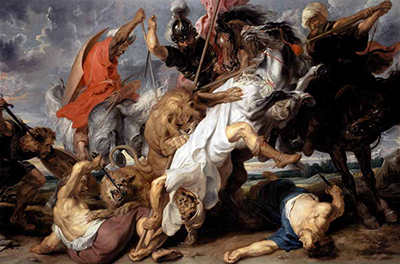The Lion Hunt by Peter Paul Rubens is a 1621 painting held at the Alte Pinakothek art museum in Munich's Kunstareal area.
It shows a group of hunters out to hunt a lion but instead they get hunted themselves. What's more, in this painting, the hunters attack two lions while on horseback and on foot. Rubens, a famous painter of the horses, has accomplished and masterfully captured the thrusting spears, the movement of the rearing horses as well as the terrified faces of the men as they fight back to defend off the attacking lion.
Rubens' depictions of exotic and wild animals resulted from inspiration from adventure stories of his well-to-do patron's in far off lands. The lion hunt painting shows an end of an exhaustive creative artwork for Ruben's centred theme of hunting. In this artwork, there is a horizontal slanted plane and a circular viewing process. In the foreground, we see the lion biting the hunter. The hunter's shield and his horse face the opposite direction, showing how Rubens succeeded in establishing each character's correct proportions.
Another hunter has a bold red paint with the gaze facing the ground, where we see an additional hunter with a lion on top of him. The hunter's dagger points at the lion, and it looks like the lion is about to fall on him. He is ready to stab the lion. The hunter in white has his foot point out to another fallen hunter painted in blue and to the right there is a darkened horseman. The dark horseman raises a rope that takes the spectator back to the circular viewing process.
Also, the tortured hunter in complete white is something the viewer cannot fail to notice. The lion from his horse rips his body. Rubens was a painter producing portraits of mythological and allegorical subjects using his unique and immensely popular Baroque style. The type of style emphasized colour, movement and sensuality. He creates a dark background and prominent figures that are simple to point out amongst the chaos.
The colour palette for his lions includes strong brown and yellow for definition and muscle contortions. Swift brushstrokes that are smooth and detailed are used to accentuate the lion's mane's exotic and sensual texture. He uses intense blues and greys for foreign skies, with yellow and dark greens for the dusty earth. Also, the tortured hunter in complete white is something the viewer cannot fail to notice. The lion from his horse rips his body.
Rubens got his inspiration from Leonardo da Vinci's work of The Battle of Anghiari and he created a drawn version. There are several other works of this kind by Rubens such as Hippopotamus and Crocodile Hunt, 1616 and the Tiger and Lion Hunt, 1618.




